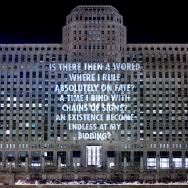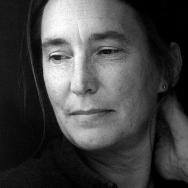Editor’s note: Jenny Holzer’s YOU BE MY ALLY has been extended through Dec. 4. Visit jennyholzer.uchicago.edu to learn more about the web-based AR app and site-specific experiences on the University of Chicago campus.
For University of Chicago student Zahra Nasser, this October marks the culmination of months of hard work—and the chance to see it shared not only on campus, but around the world.
A fourth-year College undergraduate studying art history and philosophy, Nasser is one of 10 current and former students involved in YOU BE MY ALLY, a groundbreaking public art commission from acclaimed artist and alum Jenny Holzer, EX’74.
The artwork uses both a web-based augmented reality app and LED trucks to share texts from UChicago’s multidisciplinary Core curriculum and nonpartisan get-out-the-vote messages created in partnership with UChicago’s Institute of Politics.
While the project draws material from the Core curriculum—the common academic foundation for College students—the public nature of the artwork also means its content can transcend the University.
“Part of the beauty of the project is that it challenges us to reevaluate these works in a public context,” said Nasser. “It’s different seeing the words projected on a building instead of inside a book.”
Public, yet personal
Through virtual projections on the AR app, YOU BE MY ALLY animates quotes from writers such as Audre Lorde, Friedrich Nietzsche, Hannah Arendt, Plato, W. E. B. Du Bois and Toni Morrison. For the UChicago community, seeing the texts move across campus landmarks—from Cobb Lecture Hall, to Rockefeller Memorial Chapel, to the Joe and Rika Mansueto Library—creates an important shared experience in a time of social distancing.
Launched on Oct. 5, the app currently allows viewers to project selected quotes on campus buildings, while the title can be projected at any location. On Oct. 30, viewers will be able to project all 29 quotes anywhere in the world.
“This project has been incredibly rewarding in so many ways,” Nasser said. “The fact that this is happening during a pandemic is especially significant for me, because it’s made me feel connected to the UChicago experience in a really profound way—both architecturally and by engaging with the texts that have informed so much of my thinking.”
Fellow fourth-year student Emeline Boehringer, who has been involved in the commission since last fall as a Metcalf intern and undergraduate research fellow, agreed.
“One of the cool things about this project is that the Core content selections resonate differently now than they did at the beginning of the project, before COVID,” said Boehringer, who studies art history with a focus on contemporary art. “They’re also paired with campus buildings, so there’s an architectural component that adds another layer of meaning.”
Boehringer managed faculty and student submissions of quotes from more than 50 Core texts, and worked with the Holzer studio to identify ones that spoke to the artwork’s larger themes: power, language and truth. She also met with faculty to conduct in-depth research on the Core’s history, pedagogy and contemporary significance.
“The Core goes beyond individual texts to ask the question: ‘How do you build a canon?’” Boehringer said. “That’s both a thought-provoking question and a unique proposition to offer students.”
The Core has evolved over time to include a greater diversity of voices, and student team members see that reflected in the diversity of sources the artist selected for YOU BE MY ALLY. In curating the submissions, Boehringer increasingly looked for underrepresented writers, including women and people of color.
To complement the rest of the project, Nasser is collecting recorded readings of featured texts from the authors themselves and from UChicago faculty experts. Her favorite, already available on the project website, comes from Canadian poet and classicist Anne Carson. In the video, Carson reads an excerpt from her translation If Not, Winter: Fragments of Sappho, from which the commission’s title is drawn.
Getting out the vote
A pioneer in art as social intervention who was awarded UChicago’s Rosenberger Medal in 2019, Holzer has been using writing as her medium for decades. In 2012, she contributed bronze plaques to Wall Text, hosted at the Logan Center for the Arts. Last October, her exhibition VIGIL projected first-person accounts of gun violence at Rockefeller Center in New York City.
YOU BE MY ALLY is Holzer’s first augmented reality projection in the United States—one that creates a more personal experience for the viewer. Each person will experience the projections by standing at a designated spot on campus and navigating their phone’s browser to the free app youbemyally.uchicago.edu, hosted by the web-based platform 8th Wall. When users hold their phone up to the building, an animation of the texts will roll up the building’s facade on their screen.
In addition to the virtual projections, the commission also features the use of LED signs with nonpartisan get-out-the-vote messages, displayed on trucks that will drive around Chicago on Oct. 24 and 30. Sourced from UChicago students, these new texts encourage civic participation in the 2020 election, according to fourth-year Julia Fischer, who served as a liaison between the University of Chicago’s Institute of Politics and the Holzer team.
“Jenny’s art is made for public consumption, and that gives it great accessibility—it’s a combination that works really well for getting an important message like this one across,” said Fischer, who studies political science. “For me, it’s really meaningful. Especially in this election, when it’s so important to remind people—including those in marginalized communities—that their voices and votes matter.”
Fischer said her studies have underscored how long the struggle for the vote took for many communities, and the importance of voting today.
“Our ancestors fought for the vote, and I think that it’s important for everyone to use it,” she said. “So getting that message out there, and seeing this art installation come to fruition, is really special.”

